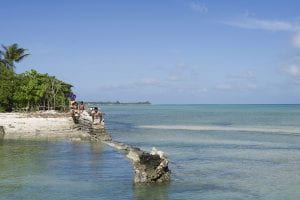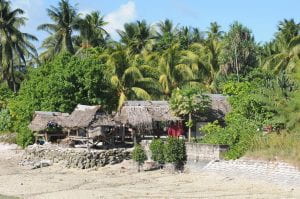By Ignacio Odriozola
On 20th January this year the United Nations Human Rights Committee (Committee) released a landmark decision on people seeking international protection due to the effects of climate change. The decision did not include specific guidance as to where the tipping point lies, but it nevertheless remains highly relevant to future similar potential cases around the world.
The case and the plot twist
The case deals with the individual communication made by Ioane Teitiota, a national from the South Pacific country of Kiribati, under the Optional Protocol to the International Covenant on Civil and Political Rights (ICCPR). Based on this Protocol, he claimed that New Zealand had violated his right to life by rejecting his request for refugee status and returning him and his family home in 2015.

Teitiota argued in his case that the effects of climate change, such as sea-level rise, had forced him to migrate from Tarawa (the principle island in Kiribati) to New Zealand. He claimed that freshwater on Tarawa had become scarce due to salinization and that eroded inhabitable lands had resulted in not only a housing crisis but also land disputes. These, combined with social-political instability, created a dangerous environment for him and his family.
New Zealand’s judicial system did not find evidence that Teitiota had been involved in a land dispute or that he faced a real chance of being harmed in this context – that he was unable to grow food, find accommodation or access to potable water; that he faced life-threatening environmental conditions; and that his situation was materially different from other residents of Kiribati.
The Human Rights Committee supported the decision adopted by New Zealand and rejected almost all arguments brought by Teitiota. However, it specifically acknowledged that “without robust national and international efforts, the effects of climate change in receiving states may expose individuals to a violation of their rights under Article 6 or 7 of the Covenant, thereby triggering the non-refoulement obligations of sending states […] given that the risk of an entire country becoming submerged under the water is such an extreme risk, the conditions of life in such country may become incompatible with the right to life with dignity before the risk is realized.” (Parag. 9.11)
This paragraph has caught international attention. To be clear, the Committee is not expressly banning the return home of someone requesting international protection due to the impacts of climate change. But it indicates that states, individually and/or collectively, could be prohibited from sending people back to life-threatening conditions if they don’t cooperate to tackle the adverse effects of climate change in those countries. If the conditions in those countries are not thoroughly analyzed before discarding risk, they could breach the powerful international obligation of non-refoulement.
Landmark decision or a passing storm?
Despite delivering an important message, the Human Rights Committee ruling does not provide explicit guidance for its implementation. Nevertheless, assumptions can be extracted from the document that shed light on its relevance and growing significance.
To begin with, it is the first-ever ruling adopted by a UN Committee regarding the claim of a person seeking refuge due to climate change. It also reinforces the idea that environmental degradation, climate change and unsustainable development can compromise effective enjoyment of the right to life, as stated previously in the General Comment No. 36 and the case of Portillo Cáceres et al. v. Paraguay.
Furthermore, despite not being legally binding, the decision is based on international legal obligations assumed by the 172 States Parties to the ICCPR, and almost 106 States Parties to the Optional Protocol. The latter allows individual claims against the ICCPR such as Teitiota’s.
Contrary to media reports, such as those by CNN and The Guardian, the Human Rights Committee did not address Teitiota as a climate refugee. Instead it considered him a person under the protection of the ICCPR whose life could be at risk of being exposed to cruel, inhuman or degrading treatment due to the impacts of climate change. This means that the Committee´s examination was based on factors and standards intended to consider if there was a threat to Teitiota’s life in Kiribati from the perspective of International Human Rights Law, which is wider and more inclusive than that of International Refugee Law.

The Committee established that individuals seeking refugee status are not required to prove that they would face imminent harm if returned to their countries, implicitly relaxing the probatory standard required for pursuing international protection under a human rights scope. It argued that individuals could be pushed to cross borders looking for protection from climate change-related harm, caused not only by sudden-onset events but also slow-onset processes (Parag. 9.11).
The Human Rights Committee has continually raised the standard of states’ analyses of protection requests. In this ruling, it recognised that New Zealand’s courts carried out a careful and in-depth examination of both Kiribati’s and Teitiota’s situations before proceeding to deport him. But alongside this it highlighted factors that must be considered in future similar cases: for example, the prevailing conditions in the person’s country of origin; the foreseeable risks; the time left for authorities and the international community to intervene; and the efforts already underway (Parag. 9.13).
In this way, the Committee’s ruling represents a significant step forward. It has established new standards that may lead to the eventual international protection of people impacted by climate change. From now on, states should examine in detail the climatic and environmental conditions of a migrant’s country of origin under the possibility of breaching the non-refoulement obligation. As the former UN Special Rapporteur on human rights and the environment, John Knox, said: “If the crisis continues to worsen, a similar case in a few years may reach a very different result.”
Ignacio Odriozola is studying the MSc in Migration and Mobility Studies at the University of Bristol. He is a lawyer for the Universidad de Buenos Aires and a researcher for the South American Network for Environmental Migrations (RESAMA).

